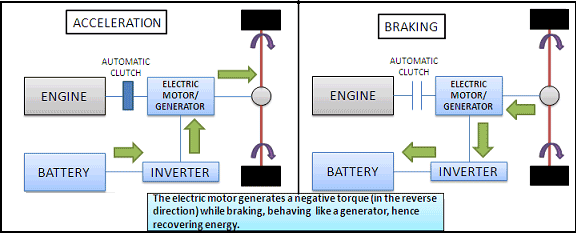Regenerative Braking
- Basic Description
-
Regenerative braking systems recapture some of the vehicle's kinetic energy when the brakes are applied and store this energy so that it can be used to reduce the engine load when the vehicle accelerates. It is widely used in electric and hybrid electric vehicles that already have batteries to store the recaptured energy. Regenerative braking has minimal impact on fuel economy during highway driving, but it can significantly improve the fuel economy of vehicles that are driven primarily in city traffic. In heavy vehicles that make frequent stops (e.g. garbage trucks), regenerative braking systems can improve fuel economy substantially.
Electric and hybrid electric vehicles typically employ motor-generators that can convert electric current into torque (like a motor) or torque into electric current (like a generator). When the brakes are applied, the motor-generator provides the resistance necessary to slow the vehicle as it supplies current to the battery. In the event that the motor-generator cannot slow the vehicle fast enough, a torque coordinator module will apply traditional friction brakes to the extent necessary.
Regenerative braking has certain limitations. In emergency braking situations, regenerative systems can neither provide the necessary stopping power nor handle the amount of electricity generated from a maximum-deceleration stop. Regenerative brakes also lose their stopping power and efficiency at lower speeds.

Flow of energy in both acceleration and braking conditions
Some regenerative braking systems store the recaptured energy mechanically, typically by pumping hydraulic fluid into an accumulator where the energy is stored in a compressed gas. When the accelerator is pressed, the direction of fluid flow is reversed, and the pressure is used to aid in acceleration. Another form of mechanically recapturing the braking energy is the use of a flywheel, commonly referred to as KERS (Kinetic Energy Recovery Systems). The energy is conserved in the form of a rotating mass and is therefore efficient, as there is no electro-mechanical conversion. Both hydraulic and flywheel systems boast higher efficiency than electric battery storage systems, but are primarily implemented only in commercial vehicles due to their size and noise of operation. These systems still require a significant amount of electronics to regulate the energy transfer and to apply the friction brakes as needed.
Porsche employed flywheel energy storage in their 911 GT3R hybrid, introduced in 2010. The flywheel could spin up to 40,000 rpm, and was capable of delivering 163 hp for 6 seconds of boost. Flywheel-based systems have also become popular in Formula 1 racing. These systems made their Formula 1 debut in 2009 and have become increasingly popular, 11 teams had implemented a kinetic energy recovery system by the end of 2013.
A mild form of regenerative braking can be achieved in non-electric vehicles by adding a clutch to the alternator. The clutch engages when the vehicle is coasting or braking causing the alternator to help slow the engine as it charges the battery that powers the starter motor and other electric devices in the vehicle. This type of regenerative braking is relatively inexpensive and easy to implement in existing vehicles An example of this technology is Mazda's i-ELOOP system. The i-ELOOP system stores the energy recovered by the alternator in a supercapacitor that helps to power the vehicle's 12-volt electrical system. Supercapacitors are used to perform this function because they can charge and discharge much more quickly than batteries. These supercapacitors can cycle through charges many more times and with less deterioration than batteries. Recent tests show that the i-ELOOP system improves fuel economy by 10% in city style driving. It only adds 20.5 lb to the car and stores up to 25,000 joules of energy.
Ford is wrapping up a 10-year research project with Samsung SDI in an effort to develop a new dual-battery system that will enable them to implement regenerative braking and idle stop-start on their non-hybrid cars. The new system would combine a 12-volt lead acid battery with lithium ion batteries. This lithium ion technology can capture up to 95% of the energy that is normally lost by braking.
The Tesla Model S allows the user to select from two different torque profiles, standard and low. The standard setting replicates engine-braking on a car with an ICE engine, while the low setting is less aggressive. The Model S electronic stability control is tied in with the motor controller so in the event of a wheel lock up the controller will reduce the torque. The next step for regenerative systems is to take over more of the vehicle braking in order capture more energy. To achieve greater braking force, the braking system will be integrated with the powertrain. The motor controller will replace the antilock braking system as well as the electronic traction control.
- Sensors
- Brake pedal position, vehicle speed, energy storage (e.g. battery) status
- Actuators
- Brakes, energy storage device (e.g. battery)
- Data Communications
- Control Unit Communication: Typically Control Area Network (CAN) Bus System
- Manufacturers
-
Bosch,
Continental,
Lightning Hybrids,
Mazziotta Motors,
TRW,
XL Hybrids
- For More Information
- [1] How Regenerative Braking Works, Christopher Lampton, HowStuffWorks.com, Jan. 23, 2009.
- [2] Regenerative Brake, Wikipedia.
- [3] Efficient Dynamic Brake Energy Regeneration by BMW, YouTube, Nov. 4, 2010.
- [4] Hybrid Buses - Regenerative Braking,YouTube, Jan. 28, 2010.
- [5] Tesla Model S Performance Energy Usage and Regenerative Braking over the 1/4 Mile, YouTube, Jun. 12, 2013.
- [6] Mazda's i-ELOOP Regenerative Braking System,YouTube, Oct. 30, 2012.
- [7] Mazda Introduces Supercapacitor-type Regenerative Braking, SAE Vehicle Engineering, Feb. 20, 2013.
- [8] Regenerative Braking - Explained,YouTube, Nov. 13, 2013.
- [9] Volkswagen Jetta Hybrid Regenerative Braking, YouTube, Jan 8, 2014.
- [10] Cadillac Wins Award for its ELR Plug-in Luxury Car, USA Today, Jan. 26, 2014.
- [11] Ford, Samsung Shack Up to Bring Regen Braking to Non-Hybrid Models , AutoBlog.com, June 9, 2014.
- [12] EN | Bosch Regenerative Braking,YouTube, Oct. 10, 2014.
|

